Milan-Sanremo is this Saturday. It’s the paradox of the longest race that is often won thanks to the finest of details and the smallest margins, a race that can look anachronistic with its distance and late action but surely the Monument where race science and aerodynamics count the most.
Read on for the things we know like the route, TV times, stats and even the weather. As for who is going to win, there’s stellar cast of contenders from grand tour winners via classics contenders to sprinters and more. Picking between them is hard which is what makes the finale so tantalising.
The Route
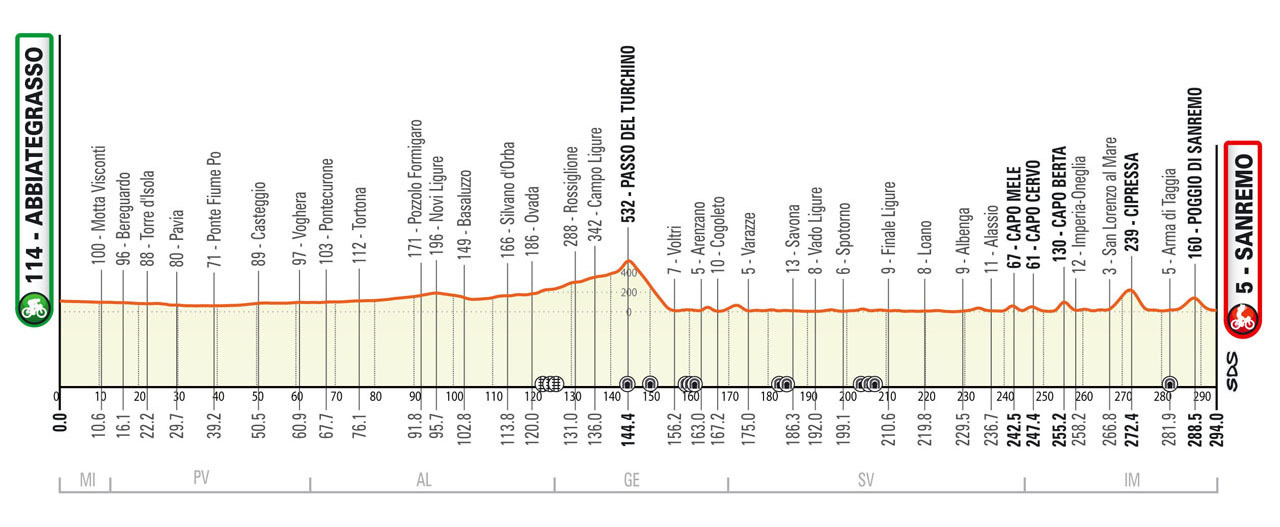
294km and a new start. No longer Milan-Sanremo, the start this year is in Abbiategrasso, a town outside of Milan. There’s a loop around Abbiategrasso before a dash south to Pavia to pick up the traditional route after 30km. The change seems anecdotal, it’s a flat start either way.
After 120km it’s Ovada and the start of the Passo Turchino. Once a climb that shaped the race, a combination of road improvements and the peloton’s ability means this gradual mountain pass is just a gentle energy sapping moment. The tunnel at the top of the pass is roughly the halfway point and the ensuing descent is much steeper than the way up, the peloton often starts to get nervous as it senses the Mediterranean below but as it’s dry it shouldn’t be inherently risky.
Then comes the Via Aurelia coastal road as the race skims along the coast, from afar we get scenic helicopter shot, inside the peloton it’s increasingly frantic with modern street furniture and antiquated town squares alike to navigate. The cape trinity: Capo Mele, Capo Cervo and Capo Berta are small climbs but serve as landmarks to break up the flat road and riders fight from position. By now the race has done 250km.

Then it’s on to the Cipressa (more detail). This starts with sharp right hander and quickly climbs through olive groves above San Lorenzo and the 9% gradient bites after 270km. This is a proper moment of climbing that ejects sprinters, the average of 4% is a blend of a steep start and a flat balcony over the top where dropped riders flounder. There’s a toboggan descent, the most technical part of the entire course. The race continues along the coastal road where teams battle to get their leaders into place for the start of the Poggio climb.

The Poggio (more here) starts with 9.2km to go and marks the final phase of the race. A furious pace is inevitable. A right flick off the coastal road and the climb begins with a series of wide bends that are so fast some riders have to brake. Positioning is everything as the road twists up, every metre matters. It’s not as steep as the Cipressa, there’s one short step at 8%, this is often the place to attack. After 287km the peloton’s brittle and the Poggio can be just enough to shatter things.
The descent often matters. It’s 3km and averages 4.5%, it’s not that technical but amid the bends and ramps if a rider can take five seconds here then the others behind will ask who can close this gap and that hesitation is enough to settle the race.
The Finish: under the 1km banner and it’s left at the fountain, then right on the wide Via Roma.
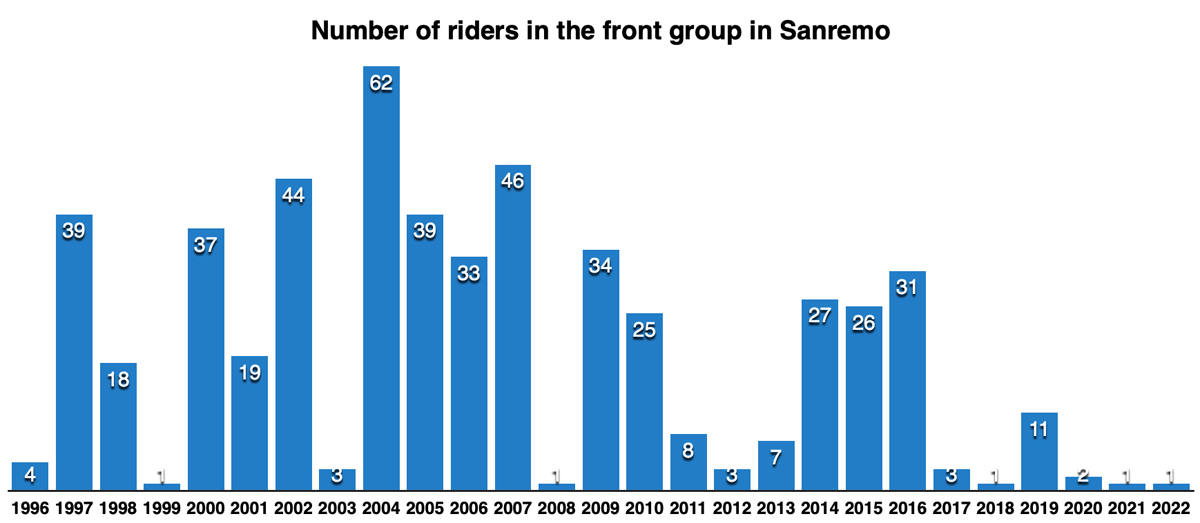
The Scenario: Milan-Sanremo might well be the race where the greatest proportion of the field starts the race harbouring private hopes of triumph. Maybe the breakaway will stick this time, maybe, maybe. However this race has long been a hunting ground reserved for star riders and even a “bunch sprint” as the chart above shows is really amid a very reduced group. The race tends to follow a pattern with the Cipressa to soften up the field and increasingly the Poggio does the same rather than being the springboard to victory. In the last two years the Cipressa’s been ridden so fast that not one rider has attacked and we have to go back to 1996 when the winning move went clear here.

The Contenders
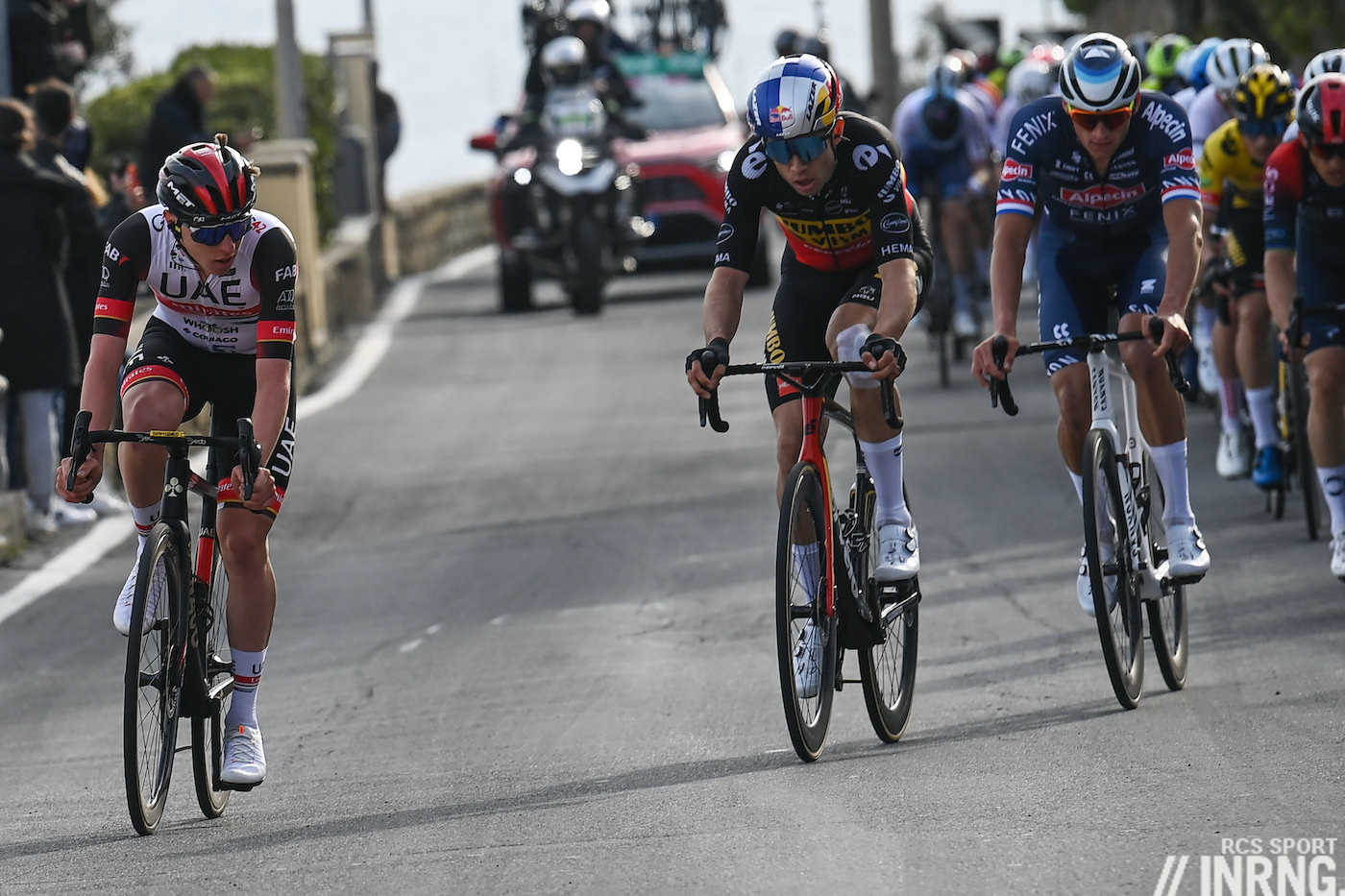
Cycling data outfit Fuoriclasse crunched the numbers in February when Mathieu van der Poel had won 23% of the races he’d started, Tadej Pogačar 22% and Wout van Aert 17% so between them so they’re the obvious three picks. That said this isn’t an ordinary race and if the career stats suit them, the two cyclo-crossers have niggling doubts over their form: they have a 0% win rate this season. Still, rivals will be watching them and even basing their plans on them, if they move so will others. Often trying to pick the winner of any bike race is more an exercise in storytelling than prediction but when it comes to Sanremo you can almost run through the whole start list and the scenario whereby each rider could win…
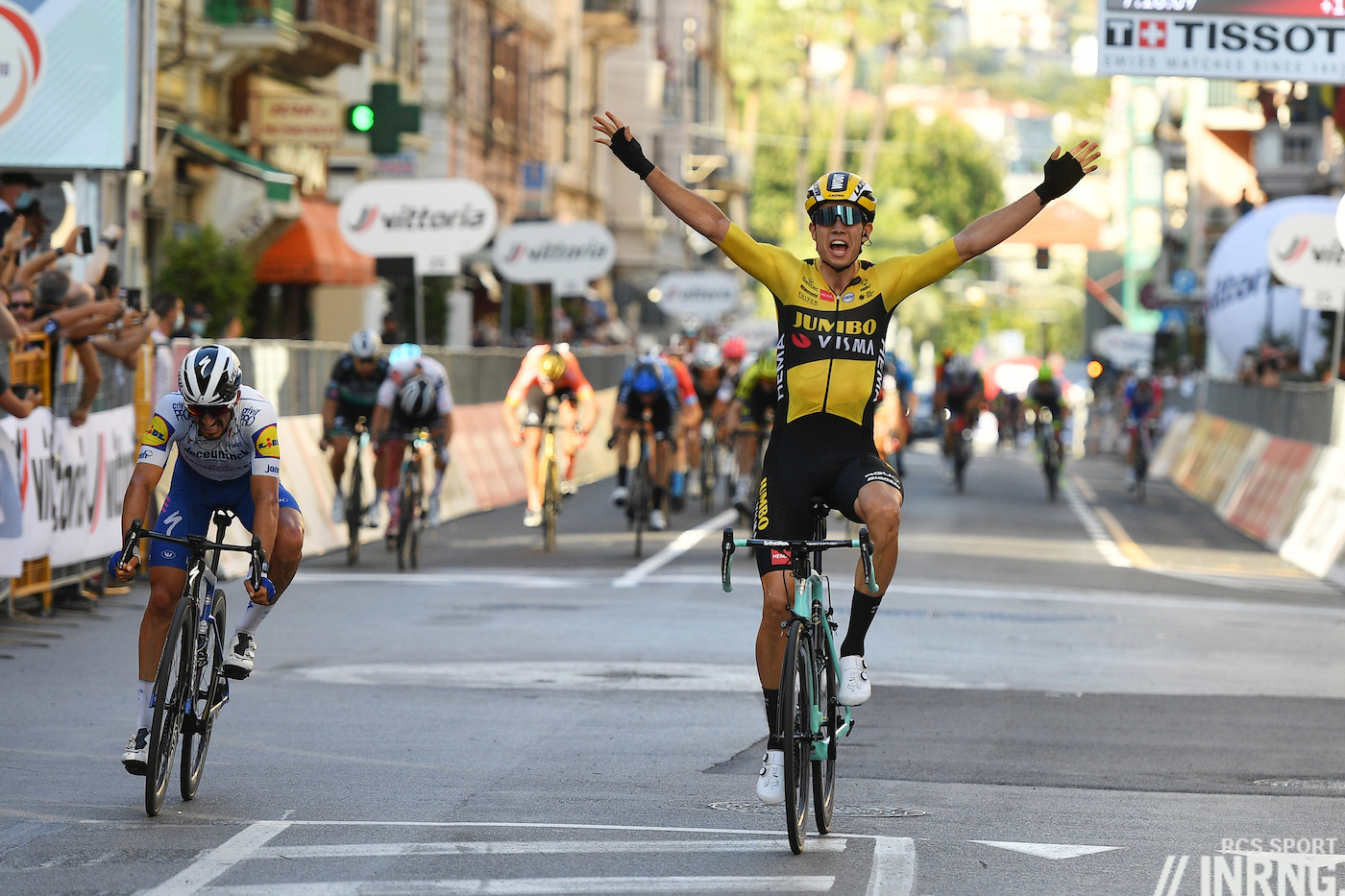
Wout van Aert (Jumbo-Visma) was looking very strong in Tirreno-Adriatico, has won this race before and he can do it all, from winning bunch sprints to surging clear on the Poggio. This is also his problem, when he moves others follow and so many will look to him and mark him. He’s also been chasing his form after a delayed start to the season because of illness. Christophe Laporte has a very fast finish too and used to have problems with races over 200km but has resolved that.
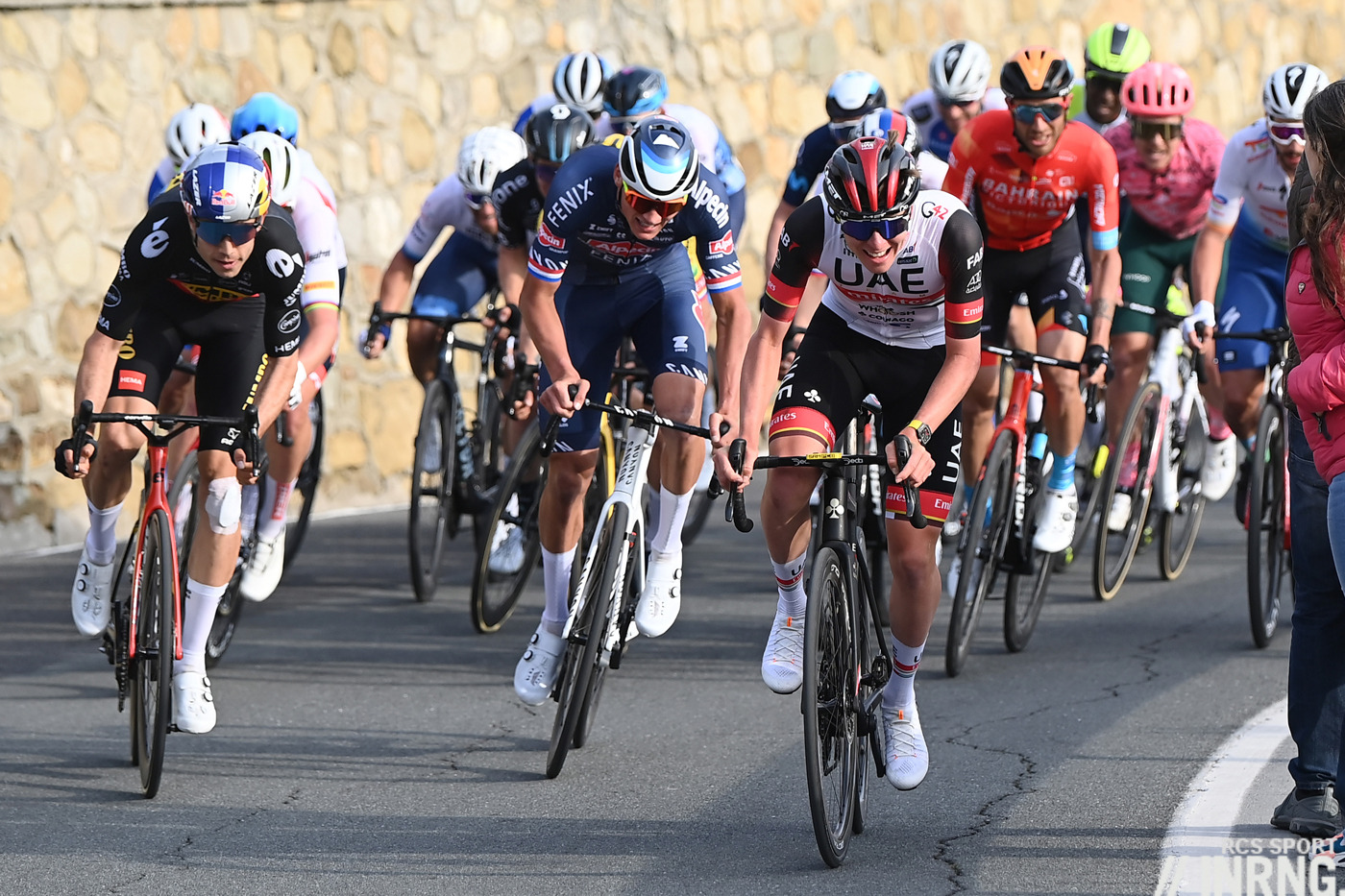
Tadej Pogačar (UAE) isn’t just a contender, his presence in the race might have rivals planning their tactics around his expected move on the Poggio. Pogačar launched here last year on only it was early, too many riders were able to jump on his wheel. So an attack later on seems likely bordering on predictable. Now he’s obviously excellent uphill but the Poggio isn’t so steep and while few dare to follow him when he surges on an Alpine ascent, for the Poggio it can pay to get in his draft right away. Perhaps he could confound predictions and go on the Cipressa as this slightly steeper climb suits more but his team have come to win rather than gamble. If he’s joined by others on the Poggio he’ll count on his sprint.
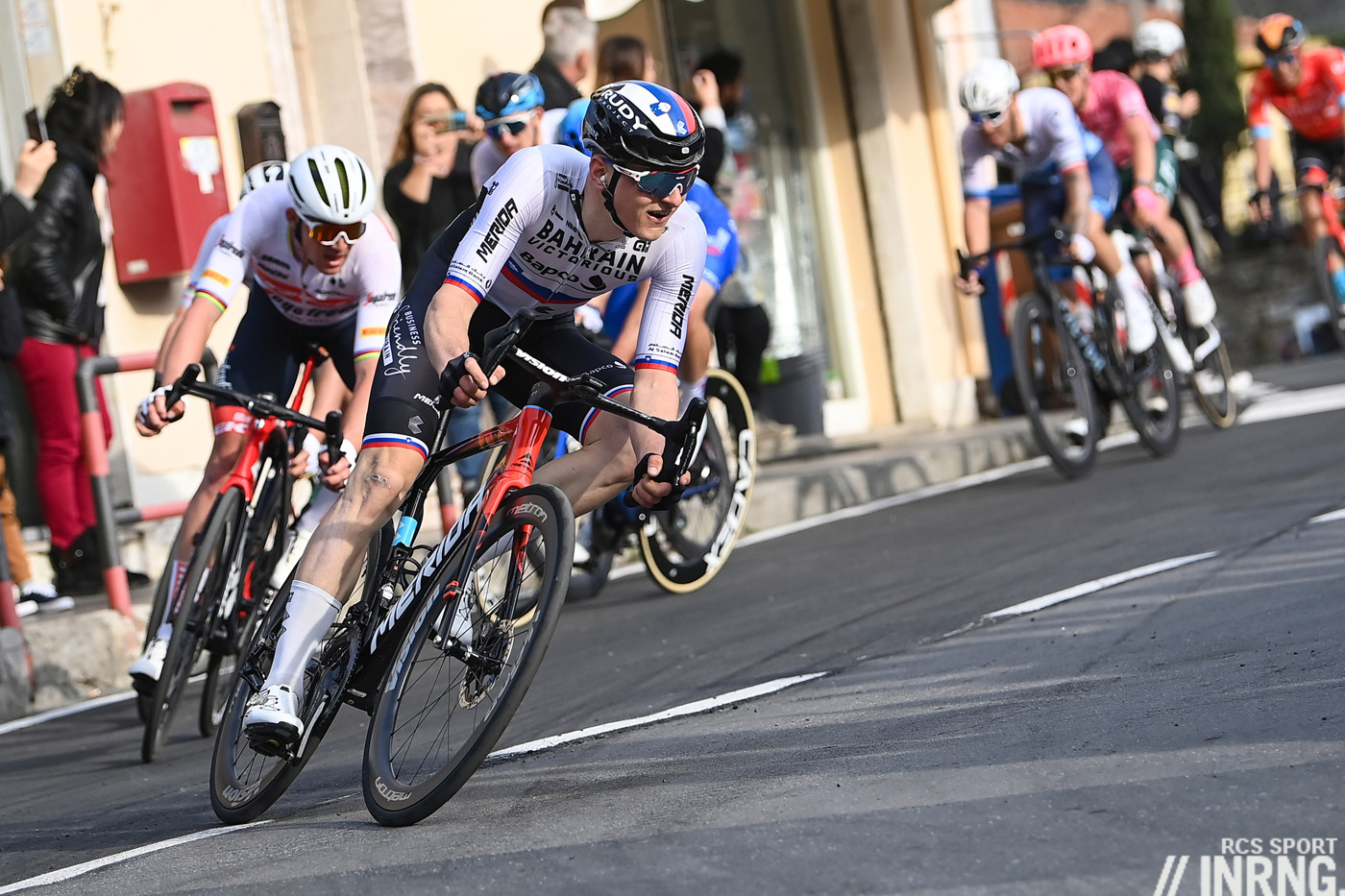
Matej Mohorič (Bahrain) won last year by attacking just before the descent and using the bends to ride away while others behind hesitated. Repeating this is going to be harder, he’s a “must follow” rider now. But good luck tracking him down the Poggio, ever since he was a child riding down the hill to his club’s group rides he’s made descending his thing. He’s got a mix of team mates several of whom could be outsiders but Mohorič is bound to be their Plan A.
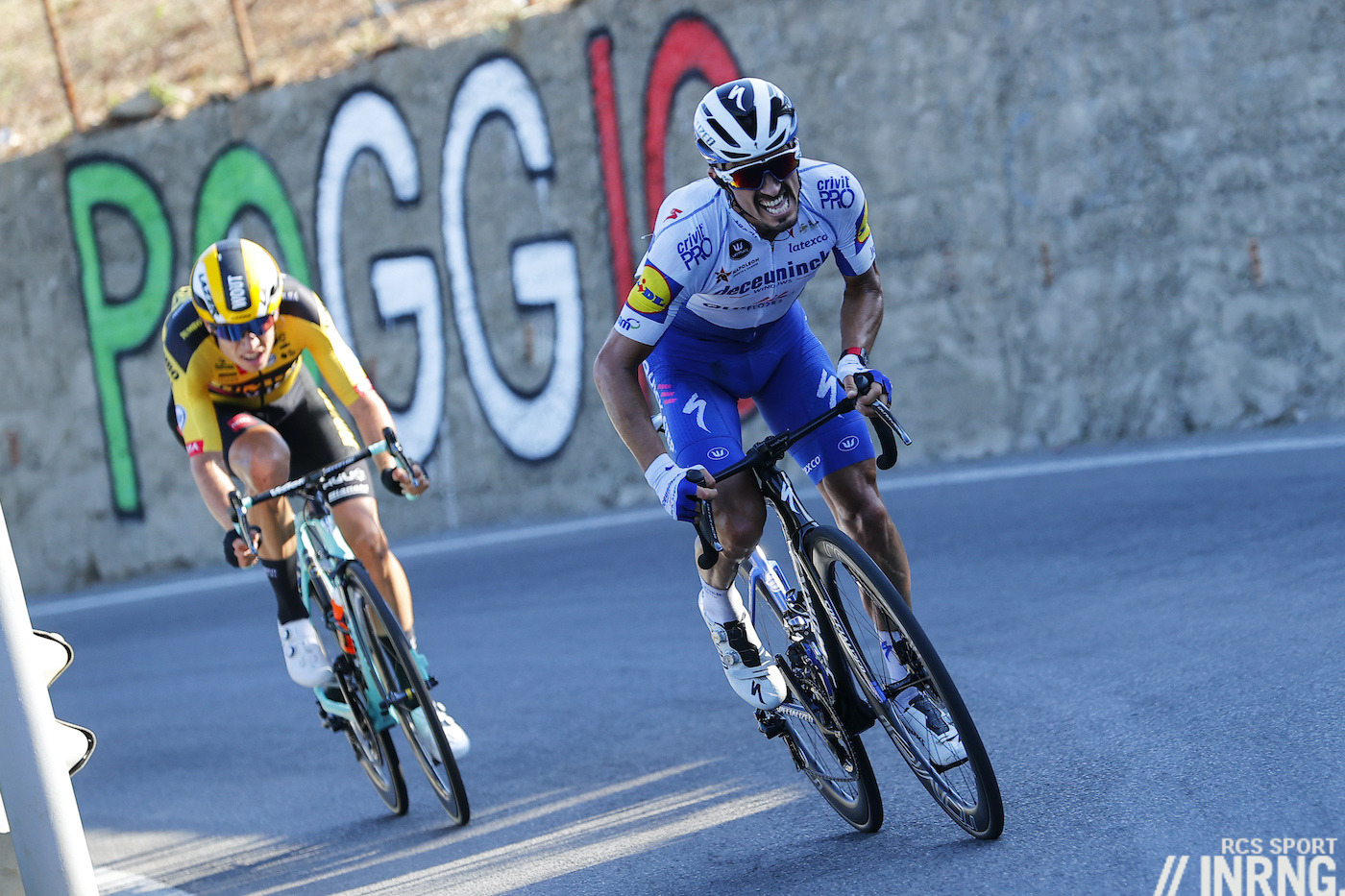
Is Julian Alaphilippe (Soudal-Quickstep) having a Philippe Gilbert moment? Once unbeatable on short climbs, Gilbert began to lose that zip and had to find other ways to win races. Alaphilippe’s past 30 now must be losing a bit of the fizzle and sizzle. The form’s not been ideal too but he’s been a canny rider too who can win the sprint in a small group. Davide Ballerini is a fast sprinter while Kasper Asgreen and Yves Lampaert can both be luxury lieutenants or reserved for an attack in Sanremo if they can make it.
Third last year, Mathieu van der Poel (Alpecin-Deceuninck) gives the impression of being able to ride through a brick wall when he’s on form, although this lack of tact is sometimes how downfall. His condition’s questionable after he was adrift on the Strade Bianche and discreet in Tirreno-Adriatico but even when not 100% he’s a force to be reckoned with. A glimpse of his form came when he launched Jasper Philipsen to a sprint win and the pair can play the old 1-2 with MvdP covering moves on the Poggio while Philipsen holds tight for the sprint. Søren Kragh Andersen is also a crafty card to play and can win à la Simon Gerrans.
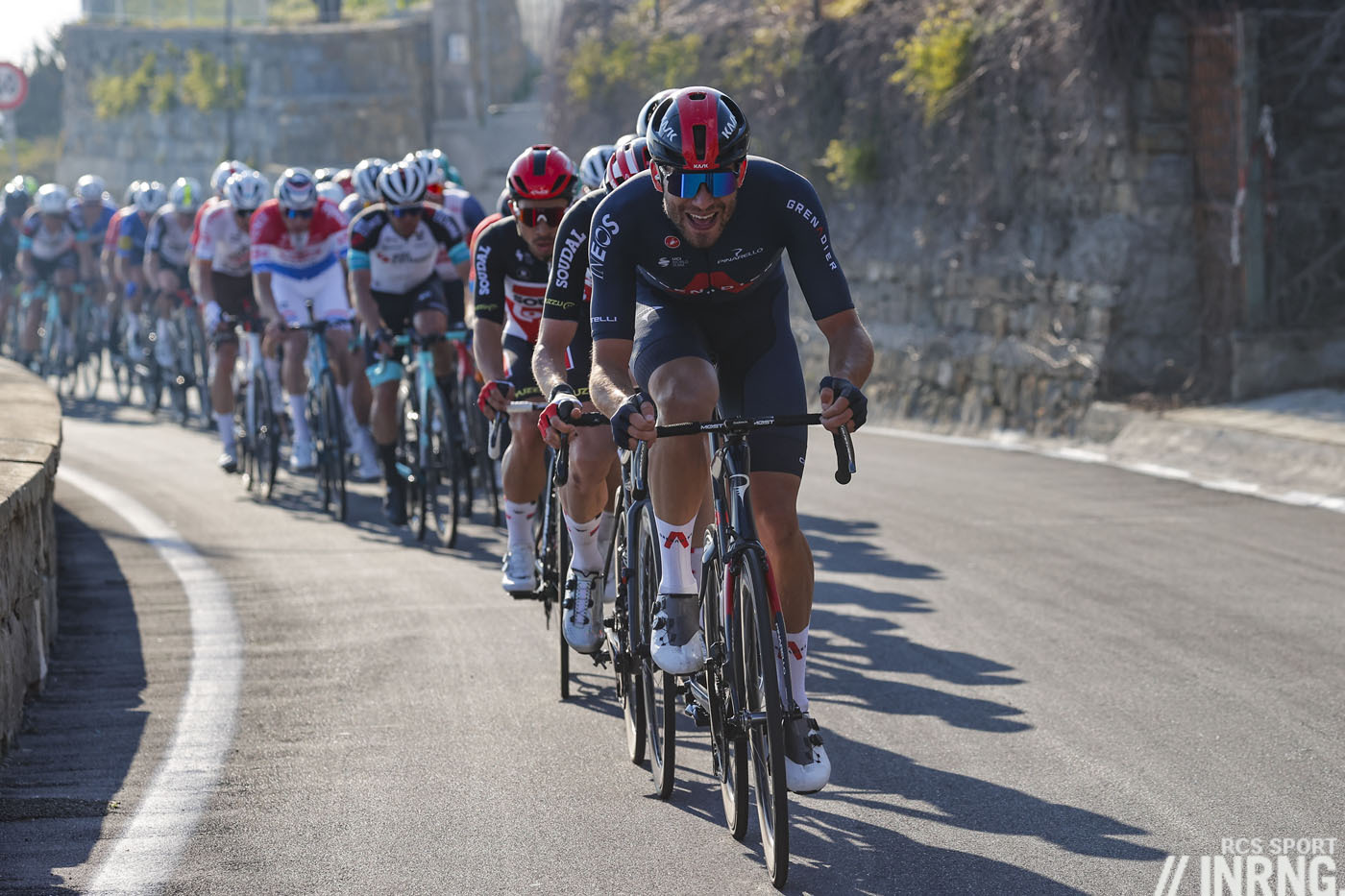
Italian hopes rest on Filippo Ganna (Ineos) and his big shoulders. He’s been visible on the Poggio in recent years, but as a pace-setter on the early slopes. This time perhaps he needs to hide on the wheels, bide his time and aim to win just like Fabian Cancellara did with a late attack in the streets of Sanremo where he can pile on the power and nobody else can match him. Easier said that done of course but in the absence of Tom Pidcock he’s their best card. Magnus Sheffield is in form too and could do a similar move too.

Trek-Segafredo come with past winner Jasper Stuyven, he did a textbook “Sanremo heist” in 2021, attacking just as the Poggio descent ended to leave the group looking at each other. Mads Pedersen seems made for this race but seems to have an on/off relationship with it, this time he’s back and looked very strong in Paris-Nice before leaving the race ill. Presumably he won’t be starting if he’s not 100% and his power and surprisingly light build makes him look perfect for the race.
Biniam Girmay (Intermarché-Circus-Wanty) is capable of winning, he’s been in the mix in the sprints of late but how to win if he comes to the finish with some of the names above? Play it calm and hope the weight of the race is on them so he can use his sprint.
Lotto-Dstny bring Arnaud De Lie and Caleb Ewan which could double their chances but equally cause confusion when it comes to team mates pacing their leaders into position whether it’s for the final climbs, or if anyone is left for the sprint in Sanremo. De Lie’s a novice but the story of his career is how each time he’s presented with a challenge he meets it; that said of late he’s done well but is yet to triumph in the World Tour and Saturday is bound to be the longest ride in his life. He’s powerful on the climbs and has a sprint but has he got the finesse for the finale? Caleb Ewan’s twice been runner-up and dreams of this race and has been thwarted by photofinish cameras so far this season.
Neilson Powless (EF Education-Easypost) has been a rider in form this early season but how to win, the climbs aren’t selective enough and his sprint probably isn’t powerful enough; he can set up the stealthy Magnus Cort who does have a sprint.
Now for more outsiders. Fernando Gaviria is looking much sharper again but still short of his 2017 form, still he’s a contender thanks to his sprint and Ivan Garcia Cortina gives Movistar another option or could help Gaviria. Arnaud Démare (Groupama-FDJ) won in 2016 but then a enjoyed an excellent start to the season with several wins, something that’s not happened yet. Sam Bennett (Bora-hansgrohe) seems capable of winning as he’s often handy on a climb but his form has looked erratic. Second last year, Anthony Turgis (TotalEnergies) is a resilient rider who is due a big win but he’s more suited to a hard day in a Flemish semi-classic. Ag2r Citroën’s Benoît Cosnefroy can deliver world-class rides and the Poggio is his kind of launchpad but the descent and tactical finish make it hard to see a win. Bardiani’s Henok Mulubrhan has had a great start to the season but the team would sign for a top-10. DSM’s best bet might be Marius Mayrhofer, the winner of the Cadel Evans road race this year who packs a punch and sees himself as a classics rider. Israel-PremierTech bring veteran Sep Vanmarcke but Corbin Strong could be the one to watch.
| – | |
| Wout van Aert | |
| Mathieu van der Poel, Mads Pedersen, Tadej Pogačar | |
| Matej Mohorič, Jasper Philipsen, Filippo Ganna, Caleb Ewan | |
| Girmay, Alaphilippe, De Lie, SKA, Cort, Laporte, De Lie, Gaviria |
Weather: textbook weather for La Primavera, a cold start at 3°C but once over the Turchino, sunshine and 15°C. They’ll be a hefty 30km/h tailwind for much of the Via Aurelia which means a crosswind for the Cipressa and Poggio in places.
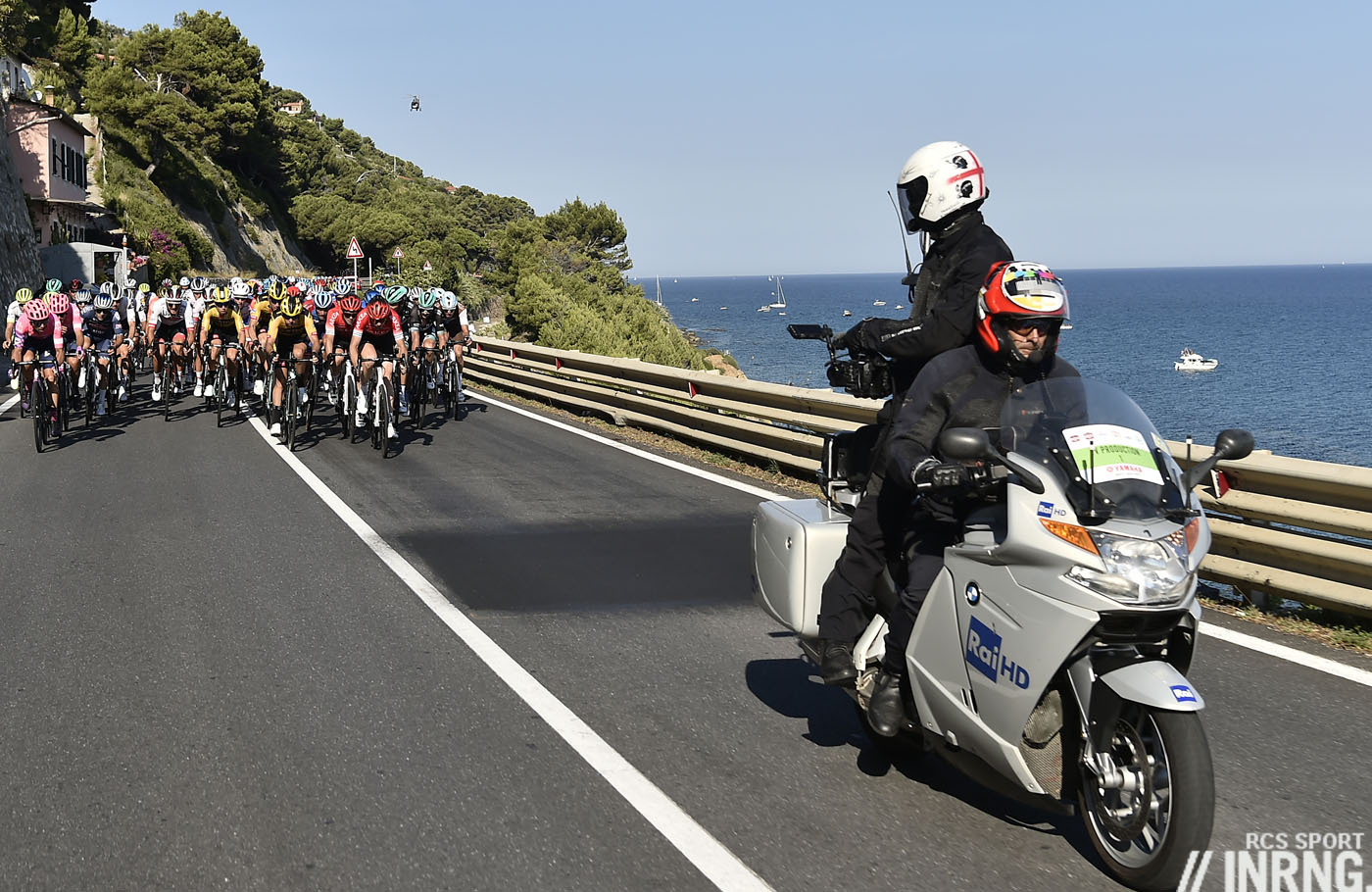
TV: live from start to finish on RAI for locals and Eurosport/GCN. The neutral start is at 9.55am CET and the finish is due around 5.10pm CET. By all means watch all of it but if so treat like radio, something that’s on in the background. If you plan to tune in later, the Capi start around 3.45pm and the Cipressa an hour later. US readers should double-check as it’s the time of year when the US and Europe are out of sync between the seasonal clock changes.

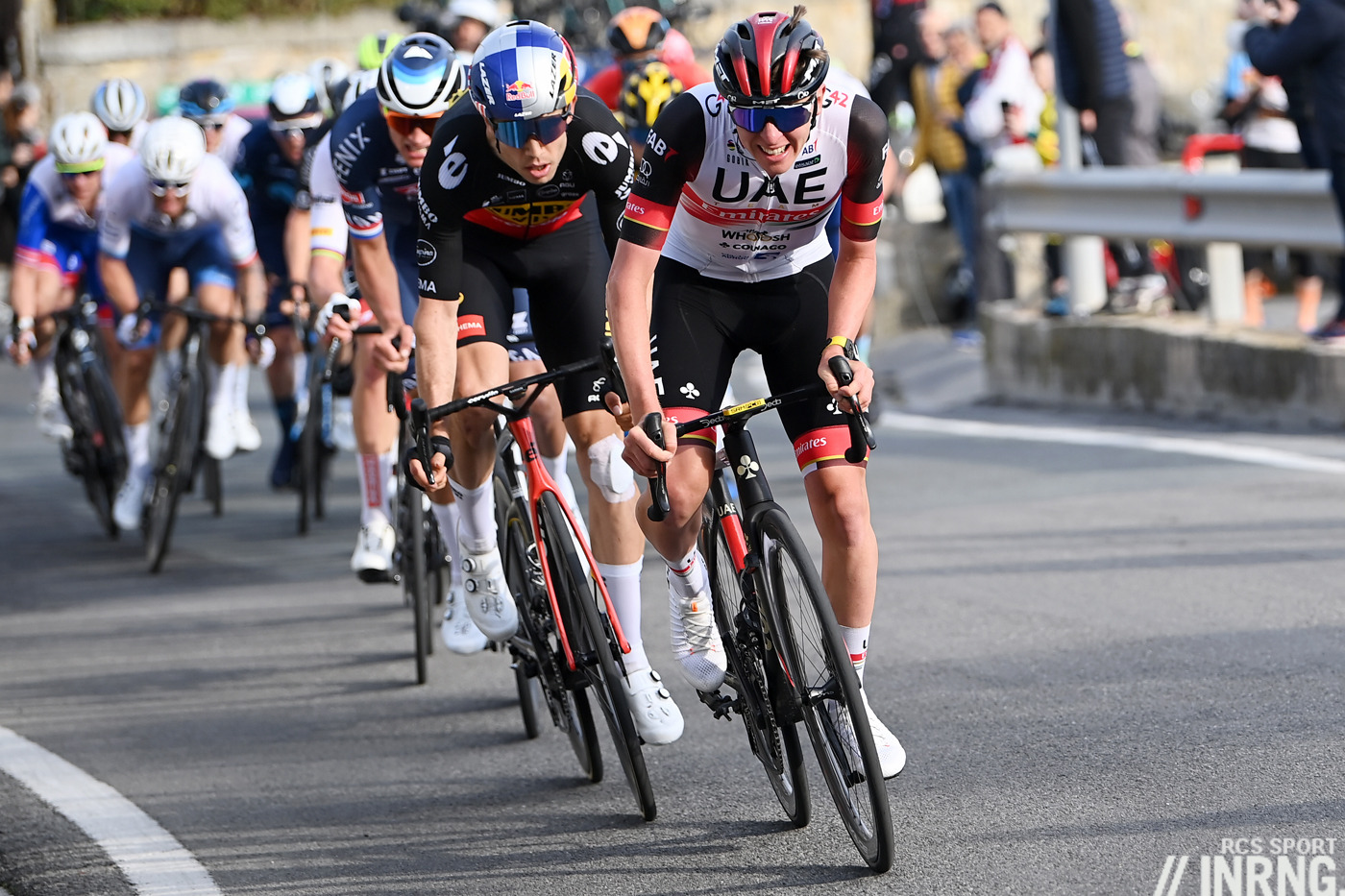
Why do big teams don’t try to send one good rider up the road in the Cipressa, and prefer to go à bloc ? Wouldn’t it be preferable to have someone up the road and make the others work ?
I agree, it’s worth a go, unless you have one of the absolute favourites, perhaps.
However, if I was UAE’s DS, I’d have them battering along from the start of the three Capi, and particularly on the Cipressa and the Poggio, in order to try to soften up everyone else. Probably still wouldn’t be enough to really badly affect the likes of WVA, et al, but worth a shot.
Essentially, because that might mean allowing others to choose the very exact pace they want to climb Cipressa, then turning the speed on only when the terrain goes flatter and the heavy men suffer less.
Instead, you need the rivals to suffer as much as possible where they actually struggle.
Plus, any lone fugitive or small group would suffer infinitely more be it only to stay away during that terrible quarter of hour before the Poggio starts, hence making ’em an easier prey in the finale. It gives substantial room to the bunch: the difference between a fast Cipressa (by gregari) and a calmer one (good for half of the bunch at least) is at the very most 45″ to 60″, which, as I said, can be taken back completely – or as much as required – with a lower toll for the peloton.
This is oversimplification, of course. Favourable wind helps to stay away. What if a team sends up the road on the Cipressa two or three riders? What if nobody helps behind because they all want one single favourite team to take responsibility and we get a Mexican standoff for the bunch?
So often it’s all a thin equilibrium threaded by collective, implicit decision on the spot, which leads not only to different editions, but also to different eras in terms of racing style and options.
Grazie Gabriele)
It’s also been so hard to attack here as teams have driven the pace, you just can’t come off the wheels, accelerate and take much of a gap.
Rather than one of the secondary riders… I still wonder if UAE could do a big leadout into the climb, as many expect of them, and Pogačar then goes here but it takes a lot just to get a gap and then hold it, the flat section along the coast by Arma di Taggia suits teams in trains chasing too.
Or maybe try to make a hard pace in the Turchino for UAE ? That’s what I wanted to say in the post under another article but I got confused with the Cipressa, I was felling they would do it last year but nothing happened. Maybe it’s too hard to do (you have nobody left after) and too long from the finish, it doesn’t change so much anyway ?
*feeling
The Turchino is really a false flat these days, there are interesting option on its top avoiding the current tunnel, but it would be a shame, it’ so scenic and you’d lose safety, in this case, for no clear gain. Things as they are, forcing pace there is useless, especially given that 100 pan flat kms do follow. With enough flat kms ahead, sprinters can even easily climb a serious Alpine pass, come back and recover. It’s happened loads of time even in GTs. Le Manie would be a game changer, but RCS left it out because at the end of the day it paradoxically favoured low-level victories by free-riding secundary figures. They’d maybe think again about it if we were going back to an age of excessive bunch sprintes, but, hey, just have a look at inrng’s graph above. Even if we now had 2-3 bunch sprints for the next years, still there would be no urgency to change the formula, whereas, of course, if the trend started to last half a dozen seasons…
Alaphalippe is 30! That makes me feel old. Not a single mention of the retiring Sagan as well. The only gap on his resume is MSR, shocking he never won it.
Agreed it’s the very big and most manifest gap, but given that he comes short as a pure cobble specialist (whereas he’s much more than that in many other fields, most notably daily victories in stage racing), I’d have liked him to grab at least an Amstel and a Strade Bianche, too, given that they were clearly available to him, without having to imagine any different evolution as an athlete; and I don’t add Paris-Tours only because it’s demodé (even more so the old “Paris-Bruxelles”).
Now speaking in rather potential terms, it’s a shame he never even tried Liège, precisely when you look both at his Amstel and Strade (or Brabantse Pijl, which he won, or the Canadian races, as well). Lombardia would probably always prevent him from trying a full “pokerissimo” of Monuments, but “striving for four” wouldn’t have been bad, either. On a lesser note, San Sebastián could also be there, in theory.
When one looks the sort of stages he was able to actually win at Suisse, Tirreno etc. you can’t avoid wonder what if he looked for something different, instead of thinking so much about Specialized’s interests. When through your whole career you’ve raced broadly as much kms in Belgium as in the USA plus Canada, you really can’t expect more triumphs on the cobbles, so perhaps being a more complete Classics rider would add shine to that famous resumé. Yet probably in Sagan’s case, as in Cadel Evans’, it’s not as much about what he won as other subtler aspects, which in a sense even changed the sport (clearly so in Sagan’s case).
I agree it’s a shame a young Sagan never tried LBL. Lantern Rouge said on a podcast a year or so ago that he thought Sagan could have won it several times in his younger days, and I’m inclined to agree. As for some of the “could have been” races you mentioned, I’ll can note that Sagan could easily have won Strade in 2012 except he had a teammate up the road having the race of his life, otherwise an easy win for Peter. And he had another second to his arch-nemesis Kwaitkowski the next year. Sagan never did Amstel during his peak years and the timing of that race always seemed at odds with his other targets, so it’s not too surprising that he had a couple of good results (3rd and 4th) without ever winning.
There are always reasons, of course. Or Boonen would have his Sanremo, calendar clash notwithstanding, and maybe the absolute Ronde record, too, if he hadn’t to play with teammates out front. And what about arch-nemesis Freire ruling in Sanremo, and Hayman’s free-riding… whatever!
As I wrote elsewhere, it’s impressive that in the sprinting years the uncontested *very top* pure sprinters in cycling history, Cipollini and Cav – “pure” and yet both more solid and complete than, say, a Kittel – could win just one each. A step down, same for Petacchi.
It just shows how hard you need to try and try and try to grab it, plus the level of absolute mastering and the class of Zabel or Freire (even more so in the latter’s case as he often didn’t have a powerful support team).
On the face of it, regarding Sagan’s career as a “what might have been” feels a little absurd given how much he did actually win and the quality of his prime. Sure he missed some big targets but what he won ought to satisfy anyone.
And, well, not a single mention either for former winners Kwiatkowski, Cavendish and Degenkolb! What to say? Just… “time goes by”, as you noted above about feeling old ^___^
Nice preview, thanks! Despite this: “…surely the Monument where race science and aerodynamics count the most” (who cares?) and this: “No longer Milan-Sanremo, the start this year is in Abbiategrasso, a town outside of Milan.” (Sad not to see ’em in front of the Duomo, WTF?) I’m looking forward to the beginning of the real cycling season. Forza Ganna! Forza INRNG! 🙂
Ooops! That was me above in case anyone wondered 🙂
I think we could tell 😉
LOL!
Yeah, yeah, I know. But I don’t want to be “one of those” who doesn’t have the cojones to put his name on his post (rant) 🙂
The 2018 edition is one of my very favourite bike races. My wife and I were leaping around, urging on Nibali (the shark ahead of the shark-like peloton), and for the first time the excitement seemed to infect my son, then a toddler, when we cheered loudly at the end. How could he know the effort the riders had put in when demanded “Again, again”?
This is a roundabout way of me saying I’d like a bit of that magic again tomorrow. But with a substantial difference. Pogacar will be holding off a closing bunch, his sensational attack on the Cipressa paying off.
There is no more spectacular sight in professional cycling than the peloton charging into the bottom of the Poggio at crazy speed. It’s possibly my favourite moment of the entire season. Not sure who the out and out favourite is, probably Pogacar. I’d be willing to front up a pretty decent amount of cash to see him go all out from the bottom of the Cipressa. Can’t see it happening though. Quick Step seem to have an ideally balanced team with Alaphilippe for the Poggio, Asgreen to ‘do a Stuyven’ and Ballerini for a reduced sprint (that he’d be doing very well to win!). I think I’m hoping for a Ganna win with a late burst just as the sprint is lining up.
The lead up to Arenberg, perhaps? Something about the downhill into the Trench funnels doom more than an uphill crescendo to me. It’s much earlier in the race, I suppose, but focalises the rest.
On another quick note, it is nice to read the regular but reasoned polemics from dedicated contributors below the line. Even when accidentally anon, they leave their tell tale traits. Even when I disagree, I love hearing the alternatives. Thanks to inrng for allowing the reasoned debate.
Just to add some rings to inrng’s, although long shots, at Ag2R Vendrame looked faster than previous years, during this season start – his teammate Oliver Naesen, once a great hope for the cobbled races, has a runner-up spot in Sanremo which turned out to be his best result ever in Monuments (albeit those two top-10s at Ronde aren’t bad, either).
Hard to expect much from him, but Ganna’s “track fellow” youngster Jonathan Milan (22 y/o) showed he can be fast on the road for his Bahrain team, too – just in case that Mohoric’s move doesn’t stick. It will be a hard day for him, anyway, which is why theoretically more suited Pasqualon gets #1 (but I think he never made top 50 here!). I’d go with Milan (Fred Wright on the Cipressa? ^__^).
Speaking of track, have a look at another rider who also just had great Championships, Simone Consonni, at Cofidis with fellow “pocket sprinter” Coquard, both assisted by Cimolai. They really need to punch above their weight, but who knows, isn’t this Sanremo?
Strange not to see Bettiol listed in the “team by team” analysis, but I’ll concede he never did great here.
Some names I was thinking about too. Ben Swift looked good in Paris-Nice and is almost a Sanremo specialist but to place rather than win? You can have a long list but look at the winners in recent years and they’re all team leader / stars.
As you hinted at in the piece above, and speaking of Modolo, too, it’s rather an excuse of sort to cast some light on a handful of “minor” names… who can have they their day of partial or marginal limelight nonetheless.
By the way, agreed on the point you make concerning Modolo, yet in contrast with Anon I don’t think it detracts anything from the race.
Lastly, anybody knows why Dainese is out? I saw a DNF in Danilith Nokere Koerse but don’t know if he crashed or whatever. He was looking quite fast.
According to DSM’s Twitter feed at https://twitter.com/TeamDSM/status/1636638533023612929 Unfortunately
@alberto_dainese won’t start #BredeneKoksijdeClassic for us today, as he’s not fully recovered from the sickness which saw him drop out of #DanilithNokereKoerse. We hope you feel better soon, Alberto! 💙😊
“sickness” could be anything but there does seem to a bug (covid maybe?) going around the peloton.
Thanks!
Read somewhere that the start has changed because of a clash with the stramilano half marathon with 50000 runners. But this has been going since 1972 and don’t think it’s been an issue before. Why is the Milan municipality allowing both events on the same weekend? The running race could be held next weekend and still not clash with Easter
The two events have been on the same weekend before (the run is on the Sunday), so unclear why it’s a problem this time.
A mere money thing, Milano was being paid to host the start, in this case especially to refund the extra hours of local police, Abbiategrasso instead is willing to pay everything plus a fee to RCS. It’s a pity because that Milano early start in the gray morning was one of those little fascinating details which didn’t often make TV, more about being there and living it. This year RCS didn’t even call the Milano municipality and just said goodbye, as for Mi-To or the Giro finale (not uncommon at all, always because of the same reasons). Milano didn’t care or didn’t notice. Italian cycling as a sport started there, but the city’s spirit has changed so much…
A real pity IMHO. Abbiategrasso-Sanremo? NFW! Fix this RCS!
Thanks Gabriele. That makes more sense although regrettable
Glad to see Magnus Cort mentioned here. Obviously he is not among the heavy hitters like WvA and the like but we’ve seen this race generate wins by a number of riders whose palmares don’t seem quite up to it but who have impressively fast and creative tactical judgment. Cort is a strong rider no question but most of his wins seem to come off of a last minute judgment that is brilliant only in hindsight, exactly what wins races like MSR. I’d not put money on him but would love to see him pull it off.
Cort, as much as I like him as a rider, has won 1 one day race, the 190km Clasica de Almeria. He is most famous for winning stages, especially in the notoriously micro staged Vuelta. I’d be surprised if his first major one day win comes in a 294km race. But stranger things have happened I suppose.
I would love to see Cort at the end of MSR with a chance to win, but I think your analysis is right on. He seems to do best when he’s surprising people during a stage race, when focus is necessarily 100% for all riders on winning that particular race. It seems like he should have the toolset to do well in this race, but I don’t think it fits his personality and nature.
I just checked and Cort did well in his first three MSR participations in 2017-19, finishing 11, 8, and 15, but didn’t do anything in his next two participations and skipped it last year.
The distance is not the problem for Magnus Cort, the fight for positioning is. It is his Achilles heel and goes a long way to explaining why 24 of his 25 pro wins come in stage races. Cort has the the punch and the sprint to win in a variety of ways from a small group, whther it is a breakaway or a much reduced bunch – but position yourself poorly in a classic and your chances of winning are fairly limited…
PS This year Cort will skip the northern spring classics completely, his next goal will be that stage win in the Giro.
A reduced sprint could help him, he wins when people often don’t expect it. But he’s just one among many who have a chance.
“Obviously he is not among the heavy hitters like WvA …” That’s a huge help, of course, especially here as he won’t be so heavily marked. I’m seeing a de Lie, a Laporte, or a Cort more likely than a Pogacar or WvA. Or maybe a crafty Mohoric type, reacting less to Pogacar than to the reaction of the peloton to Pogacar.
It feels like an absolutely huge ask for de Lie, who has never won a WT race or a race over 203 km to win this long monument that so many other riders are targeting. Girmay’s Gent-Wevelgem win last year to me is a solid marker that he has a chance here, and I don’t see anything like that in de Lie’s palmares. And Laporte was second in that race, which probably bodes well for him, too, though his longest win is only 208 km and he (surprisingly) only has a couple of WT wins to his credit at the ripe ol’ age of 30. And he’s never finished higher that 22 in multiple MSR starts (Girmay was 12th in his first and only MSR at a 21 year old).
And that’s why MSR is such a wide-open crapshoot. The favorites are marked, the heavy favorites are heavily marked, and the ones who haven’t shown much previous in a monument are in with a chance. MVdP said that you don’t have to be in the top of your form to win this one. The strong may have an edge but it isn’t a big edge.
“MVdP said that you don’t have to be in the top of your form to win this one.” Geez, just when I was warming up to this guy he says this? If his name was on the winner’s list I’d give that a bit more credibility, but I’d be happy to see him win and prove it.
You sure love to take an instant dislike to riders based on the flimsiest evidence:-) A more boring character like myself would probably say “hey what?!” and try to look up the interview to see what was actually said and to make sure the quote, taken out of its context, could misrepresent the rider’s comment.
“In my first race last year I finished third, whereas you would never do that in something like Strade Bianche. You can’t finish third there if you’re not in top form, but you can in Milan-San Remo, which says enough about this race,”
and
“You don’t have to be the best to win Milan-San Remo.”
I don’t have an argument with either of the above. MvdP isn’t, in my humble opinion, either slighting MSR or bragging that he is special. Or whatever rubbed you the wrong way.
Saturday – I looked up the quote and stand by what I wrote…all of it including “… I’d be happy to see him win and prove it.” which wasn’t supposed to be sarcastic…I really would be happy to see him win it and prove his point, OK?
MvdP already proved the first point when he came third. And I don’t think there is a serious argument against the second point.
But let’s leave this fruitless discussion behind and concentrate on the race as the suspense builds up in the minds of avid fans!
Saturday – OK we can leave it with “You don’t have to be the best to win Milan-San Remo.” that was somehow proved “(MvdP already proved the first point) when he came third. ” But don’t call me convinced there’s any logic there.
Whast’s the matter with you – on a day like this?!
The first point was, of course, that “you can finish third in San Remo when you’re not in top form” which he proved by finishing third last year.
I think it takes top-form (which he hinted at in the post-race bit) to actually WIN the thing rather than get 3rd, otherwise his rivals are gonna have some sleepless nights.
CHAPEAU MvdP!
I’m struck by the stat that MvdP has won 23% of the races he’s started, since I already see him as being on the downward slope of his road cycling career. I knew he’s won a high percentage of his early road races, but I assumed the winning percentage had dropped to lower than 23% by now. My sense is that we’ve seen peak van der Poel and while I’m sure he has some big wins left in him, I think his reputation as a regular world-beater is perhaps no longer deserved.
I just checked, and he’s won just one race out of his last 48 starts (barely 2%!), and even when he was winning a large percentage of his races, the wins usually weren’t WT-level (16 out of 40 wins, if I’ve counted correctly). Yes, he has two Ronde’s, an incredible Amstel Gold, a Strade Bianchi, and a single TdF stage, but otherwise nothing too gaudy. And that’s realizing that he’s apparently been in the enviable position of picking and choosing what races he wants to do, unlike the vast majority of racers who need to follow team or sponsor dictates. My guess is he’s definitely worth a chain ring here, but three rings feels awfully generous.
This seems extremely premature. Especially considering he won the Ronde last year. When he first started out on the road he did a lot of minor races. Now he doesn’t. That’s probably the effect you are seeing. Count him out of any major one day race bar Lombardia at your peril.
Yes, I know this is a hot take, and I’m sure that’s the reaction of most people. It certainly fits with the conventional wisdom about cyclist’s careers, but just for fun I’m willing to put down a marker and revisit this opinion in a couple of years to see how prescient I’ve been.
I’ve been whiling away some free time looking at typical cyclist career trajectories, and what I’ve noticed is that in recent times most winning riders peak at about age 26, +/- a year. Plus MvdP has been riding himself ragged doing both an elite road career (albeit with fewer race days than most top riders) and an elite CX career. And then there’s that back injury he had last year. Back injuries tend to be chronic, and to become nagging. Note that I didn’t say he’d not win more monuments and big races – it’d be shocking if he doesn’t. I just think the pattern of much fewer wins per race days will continue. I especially expect him to continue to animate races, much like Sagan in 2019-2020, but I think the impression that many hold to that MvdP can utterly impose himself on races the way we’ve seen him do multiple times in the past, seemingly doing impossible feats on a road bike at will, are over.
Here’s an additional hot take – I think we saw peak WvA during the last two years, and while I think he will continue to win at a significantly higher rate than MvdP, I think we’ve already seen his best on a seasonal basis. I think his falloff will be less steep than for MvdP, but I think a pattern of steady decline starting this year will be clear in a couple of years.
@Backseat Rider, look here: https://www.procyclingstats.com/rider/mathieu-van-der-poel/results
Two of those three fall wins are ‘national’ races that PCS doesn’t register in the win totals for elite WT riders. They’re basically trivial for a rider of his stature. I’d be curious to know why he bothered, if anyone familiar with the Belgian racing scene can shed some light.
+1 Unless his back plays up…if his career ends sooner than expected I think it will be blamed on that.
I think it was clear to everyone else, but in case you misunderstood, I’m not suggesting MvdP’s career is over, nor that he’ll win no more major races. I’m saying I believe we’ve seen his peak, and that days as a justified favorite in a huge percentage of big races is no longer warranted. A few years ago people were speculating that he could win every monument and multiple WCs. So far that obviously hasn’t proved to be the case, and at this point it looks to me like that level of success is extremely unlikely. But he is an extraordinary rider, and he could prove me wrong. We’ll see.
You should factor in the fact that generally in cycling the passing of time brings on more and more radical negative racing against the greatest figures, no matter how already famous you were when you started racing in the road bunch. It’s like at first people don’t really believe what you might do until you’ve really done it a handful of times “in their faces”, so to say, borrowing from basket. At the same time, of course, the body becomes less explosive and reacts more slowly to training. Think Bettini, Cancellara…
Yes, that phenomena is automatically factored in when you analyze historical results. When I say we’ve seen ‘peak’ WvA the last two years, or ‘peak’ MvdP a couple of years ago, I don’t refer to their actual peak physical or psychological capability, but their peak relative to the peloton. A peloton that doesn’t take you completely seriously (e.g., a very young Sagan, or MvA/MvdP in their first couple of years in major races) is going to let you get away. After you rub their faces in your superiority enough times, they mark you heavily, literally racing against you, and then a lot races that would likely be wins are instead podium finishes and top 10s.
This, though, is something that I think has evolved somewhat over time. When Sagan, for example, talks about younger riders not having respect for established riders, I think he refers to some extent to this kind of behavior. Any punk with good legs will go after you, regardless of those WC strips on your sleeves. My impression is that back in the day, when the peloton had patrons who got a certain amount of deference and who demanded (and enforced) a system of respect, it was possible to have more success for longer periods of time because you had to watch out for a smaller, more select group of real competitors.
Where did you get that stat? He did have a fallow stretch after winning stage 1 of the Giro and disappearing during the Tour, but then won 3 races in the Fall.
From PCS his stats for the past couple of years:
2023: 0 wins in 8 race days
2022: 7 wins in 49 race days
2021: 8 wins in 34 race days
Not going OT re: MvdP future options and riders’ longevity in more general terms, not because it’s less than interesting but precisely given that I find the subject fascinating and it would grant matter for a whole thread (reportedly, he’s even been thinking about stopping with CX races and focussing on road only because the back issues).
However, as we’ve been speaking these days of team importance, too, well, I’d say that MvdP’s freedom comes at an obvious price, i.e. not even by far the same level of support at *each and every* level which – say – WVA has access to (in his case, too, with a – different – obvious price). Plus, there’s the specific price of liberty as such and in itself, a price worth paying, for sure, as a human being, maybe not as much as an athlete: that is, the lack of costraints may mean that you’re the maker… of your undoing, when you take decisions irrespective of expert guidance.
“that is, the lack of constraints may mean that you’re the maker… of your undoing, when you take decisions irrespective of expert guidance.”
Yes, I think this is a fair judgment about MvdP, and I’d say both his choice of race programs and his in-race strategies. How often are we watching him race and hearing the commentators commenting on his (questionable) choices, but then quickly follow it up with something like “but he’s Mathieu van der Poel, he can do what he wants and still get away with it.” Except, against top-rank competition who are wise to his raw power, he can’t regularly get away with it.
It’s perhaps his blessing and his curse to grow up a family of cycling royalty, with massive success since late childhood. Who is worthy to tell him not to follow his instincts? As a viewer, I love watching him animate races and try improbable things, so this isn’t a criticism.
And now he’ll probably do something wacky today and win, and I’ll have a nice crow pie with my Italian wine tonight.
Even more interesting as he so often, however incredible might that sound, had to face *several times* equal or superior raw power, and had to find a way to win all the same, against the likes of Pogacar and Van Aert at Ronde, Tirreno, CX races… Not that he never used that raw power, of course, think Strade Bianche against Alaphilippe or that Amstel (which was as well about «believing», anyway).
He was a late starter but now that he is doing stage races his win rate has come down a lot.
His one day race completion rate must be fairly high though. Especially monuments.
If Pogacar does not get bored and attacks from 50 km out, then I would expect a favourites sprint (unless they all stop and look at each other, then a Cosnefroy or even Fred Wright gets the win).
A few statistics of perhaps passing interest…
The median age of MSR winners is a little under 27 years old.
Five riders aged over 32 have won Monuments in the last five years. Two riders aged 22 won in the same period, none younger.
The last ten MSR winners averaged 23 pro wins at the time of their victory, with Stuyven at nine having the fewest.
In the last 20 years only two riders have won a Monument as their first pro win, the last being Bettiol at Flanders in 2019.
With thanks as always to Pro Cycling Stats!
According to Wikipedia the Via Aurelia goes only as far as Pisa … not clear where the 3p km/hr tailwind comes into the picture.
Take care with Wikipedia sources, especially if it’s not local. The Aurelia gets its name from Roman times but today it goes to the French border, it’s also known as the Strade Statale 1 / SS1.
Latest weather forecast suggests the wind’s dropping, more like 15-20km/ now.
It appears that “Via Aurelia” is used as a colloquialism these days. Of more importance is the weather report a it looks more like a 15 kph cross wind from the time that they hit Genoa. No rest for the sprinters.
After two years of disappointment I am hoping that Ewan can reverse his fortunes.
…What’s in a name? 😉
However, when you hint at “via Aurelia” being a colloquialism of sort “these days”, you must be aware that “these days” stretch back some 1.800 years at least, when the Itinerarium Antonini (sort of a ü(be)r-Garibaldi with stages and all!) was redacted, including in the “via Aurelia route” all the way to Arles.
The very first via Aurelia stopped near Pisa because of technical reasons but Cesar was already having it extended further north and west to reach Gallia more easily with troops.
Anyway, please note that as inrng wrote above, it’s not about a someway less than precise common use: in Italy national roads often have a name, besides the number, and “via Aurelia” is under every respect the official name for the SS1 road, no matter its historical origins (which anyway, as I tried to suggest here, are quite more complicated than what reported by the Wiki you looked at).
30 km/hr.
In Roman times it became Via Aemilia from Pisa to Genoa … and then north … but it seems that Mr Aemilia has been cancelled since.
Now I will look for a current toad map.
https://www.stradeanas.it/it/strada-statale-1-“-aurelia”
Having to run over too many toads would be dangerous, so checking the toad map is surely useful.
Of course, here you are, help yourself!
https://eatingcloudsinitaly.com/2021/05/14/bergamo-bubble-tea-and-toads/
And in case you you prefer Hispania, here’s an even more detailed one… for real toad lovers:
https://www.malaga.es/en/laprovincia/naturaleza/lis_cd-13147/sapo-comun-bufo-spinosus-gran-senda-de-malaga